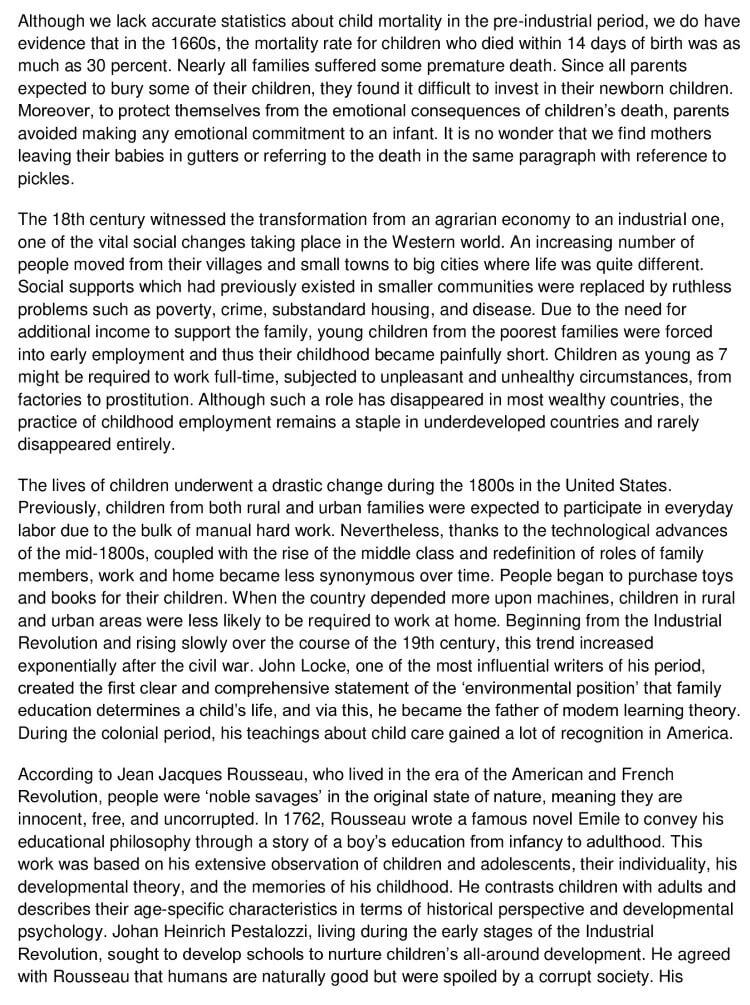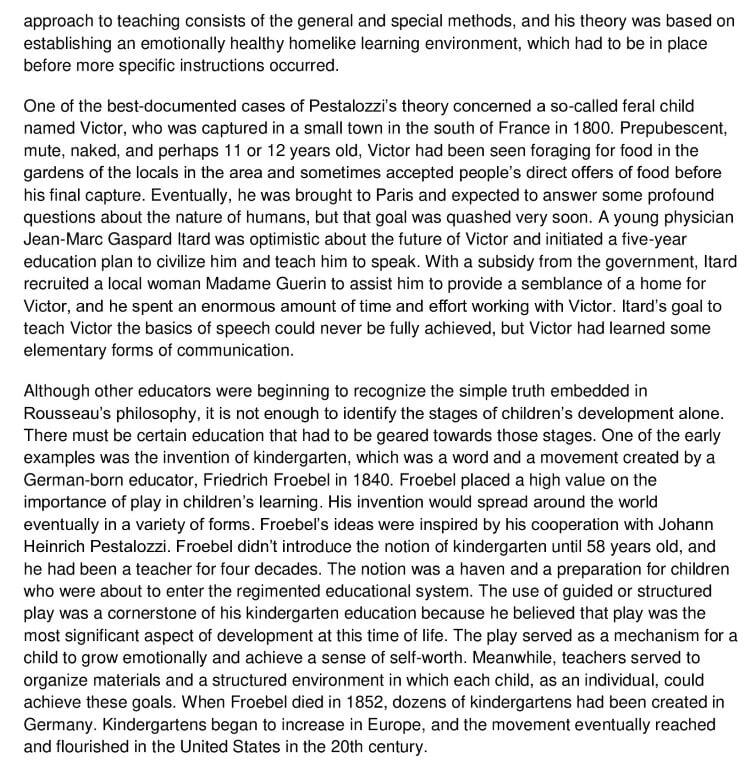Education Philosophy- IELTS Reading Answer
8 min read
Updated On
-
Copy link
Table of Contents

Limited-Time Offer : Access a FREE 10-Day IELTS Study Plan!
Reading Passage
Education Philosophy


Questions 1-4
Reading Passage 1 has six paragraphs, A-F.
Choose the correct heading for paragraphs A and C-E from the list of headings below.
Write the correct number, i-vii, in boxes 1-4 on your answer sheet.
List of Headings
- The inheritance and development of educational concepts of different thinkers
- Why do children have to work to alleviate the burden on family
iii. Why children are not highly valued
- The explanation for children dying in hospital at their early age
- The first appearance of modem educational philosophy
- The application of a creative learning method on a wild kid
vii. The emergence and spread of the notion of kindergarten
1 Paragraph A
Example Answer
1 Paragraph B ii
2 Paragraph C
3 Paragraph D
4 Paragraph E
Questions 5-8
Look at the following events (Questions 5-8) and the list of dates below.
Match each event with the correct date, A, B, or C.
Write the correct letter, A, B, or C, in boxes 5-8 on your answer sheet.
NB You may use any letter more than once.
List of Dates
- the 18th century (1700-1799)
- the 19th century (1800-1899)
- the 20th century (1900-1999)
5 the need for children to work
6 the rise of the middle class
7 the emergence of a kindergarten
8 the spread of kindergartens around the U.S.
Questions 9-13
Look at the following opinions or deeds (Questions 9-13) and the list of people below.
Match each opinion or deed with the correct person, A, B, C, or D.
Write the correct letter, A, B, C, or D, in boxes 9-13 on your answer sheet.
NB You may use any letter more than once.
List of People
A Jean Jacques Rousseau
B Johan Heinrich Pestalozzi
C Jean Marc Gaspard Itard
D Friedrich Froebel
9 was not successful to prove the theory
10 observed a child’s record
11 requested a study setting with emotional comfort firstly
12 proposed that corruption was not a characteristic of people’s nature
13 was responsible for an increase in the number of a type of school
Reading Answer
1 Answer: iii
Question type: Matching Heading
Answer location: Paragraph A
Answer explanation: Paragraph A illustrates, “Although we lack accurate statistics about child mortality in the pre-industrial period, we do have evidence that in the 1660s, the mortality rate for children who died within 14 days of birth was as much as 30 percent. Nearly all families suffered some premature death. Since all parents expected to bury some of their children, they found it difficult to invest in their newborn children. Moreover, to protect themselves from the emotional consequences of children’s death, parents avoided making any emotional commitment to an infant. It is no wonder that we find mothers to leave their babies in gutters or refer to the death in the same paragraph with reference to pickles.” These lines indicate why children are not highly valued. Therefore, the answer is iii.
2 Answer: v
Question type: Matching Heading
Answer location: Paragraph C
Answer explanation: Paragraph C states that the lives of children underwent a drastic change during the 1800s in the United States. Previously, children from both rural and urban families were expected to participate in everyday labor due to the bulk of manual hard work. Nevertheless, thanks to the technological advances of the mid-1800s, coupled with the rise of the middle class and redefinition of roles of family members, work and home became less synonymous over time. These lines indicate the first appearance of modern educational philosophy. Hence, the answer is v.
3 Answer: i
Question type: Matching Heading
Answer location: Paragraph D
Answer explanation: Paragraph D illustrates, “In 1762, Rousseau wrote a famous novel Emile to convey his educational philosophy through a story of a boy’s education from infancy to adulthood. This work was based on his extensive observation of children and adolescents, their individuality, his developmental theory, and the memories of his childhood. He contrasts children with adults and describes their age-specific characteristics in terms of historical perspective and developmental psychology.” These lines suggest the inheritance and development of educational concepts of different thinkers. Hence, the answer is i.
4 Answer: vi
Question type: Matching Heading
Answer location: Paragraph E
Answer explanation: Paragraph E states that one of the best-documented cases of Pestalozzi’s theory concerned a so-called feral child named Victor, who was captured in a small town in the south of France in 1800. Prepubescent, mute, naked, and perhaps 11 or 12 years old, Victor had been seen foraging for food in the gardens of the locals in the area and sometimes accepted people’s direct offers of food before his final capture. These lines indicate the application of a creative learning method to a wild kid. Hence, the answer is vi.
5 Answer: A
Question type: Matching Features
Answer location: Paragraph C
Answer explanation: Paragraph C states that the lives of children underwent a drastic change during the 1800s in the United States. Previously, children from both rural and urban families were expected to participate in everyday labor due to the bulk of manual hard work. Hence, these lines indicate the need for children to work. Hence, the answer is A.
6 Answer: B
Question type: Matching Features
Answer location: Paragraph C, line 12
Answer explanation: In the twelfth line of paragraph C, Beginning from the Industrial Revolution and rising slowly over the course of the 19th century, this trend increased exponentially after the civil war. These lines indicate that the rise of the middle class was in the 19th century (1800-1899). Hence, the answer is B.
7 Answer: B
Question type: Matching Features
Answer location: Paragraph F, line 3
Answer explanation: In the 3rd line of paragraph F, it is mentioned that one of the early examples was the invention of kindergarten, which was a word and a movement created by a German-born educator, Friedrich Froebel in 1840. These lines indicate that it was during the 19th century, that kindergartens emerged.
8 Answer: C
Question type: Matching Features
Answer location: Paragraph F, last line
Answer explanation: In the last line of paragraph F, it is stated that Kindergartens began to increase in Europe, and the movement eventually reached and flourished in the United States in the 20th century. These lines indicate that the kindergartens spread in the US during the 20th century. Thus, the answer is C.
9 Answer: C
Question type: Matching Features
Answer location: Paragraph E, last line
Answer explanation: Paragraph E illustrates how Jean-Marc Gaspard Itard researched the theory, however, in the last line, it is stated that Itard’s goal to teach Victor the basics of speech could never be fully achieved, but Victor had learned some elementary forms of communication. It is evident from these lines that Jean was unsuccessful in proving his theory. Thus, the answer is C.
10 Answer: A
Question type: Matching Features
Answer location: Paragraph D
Answer explanation: Paragraph D explains Jean Jacques Rousseau. In the 4th line, it is mentioned that he wrote a famous novel Emile to convey his educational philosophy through a story of a boy’s education from infancy to adulthood. This work was based on his extensive observation of children and adolescents, their individuality, his developmental theory, and the memories of his childhood. He contrasts children with adults and describes their age-specific characteristics in terms of historical perspective and developmental psychology. It is clear from these lines that Jean observed a child’s record. Hence, the answer is A.
11 Answer: B
Question type: Matching Features
Answer location: Paragraph D
Answer explanation: Paragraph D states that Johan Heinrich Pestalozzi, living during the early stages of the Industrial Revolution, sought to develop schools to nurture children’s all-around development. He agreed with Rousseau that humans are naturally good but were spoiled by a corrupt society. His approach to teaching consists of the general and special methods, and his theory was based on establishing an emotionally healthy homelike learning environment, which had to be in place before more specific instructions occurred. It is clear from these lines that Johan requested a study setting with emotional comfort firstly. Hence, the answer is B.
12 Answer: A
Question type: Matching Features
Answer location: Paragraph D, line 4
Answer explanation: The 4th line of paragraph D states that he contrasts children with adults and describes their age-specific characteristics in terms of historical perspective and developmental psychology. He agreed with Rousseau that humans are naturally good but were spoiled by a corrupt society. These lines suggest Jean Jacques Rousseau proposing that corruption was not a characteristic of people’s nature. Hence, the answer is A.
13 Answer: D
Question type: Matching Features
Answer location: Paragraph F, line 3
Answer explanation: The 3rd line of paragraph F states that Froebel placed a high value on the importance of play in children’s learning. His invention would spread around the world eventually in a variety of forms. Froebel’s ideas were inspired by his cooperation with Johann Heinrich Pestalozzi. Froebel didn’t introduce the notion of kindergarten until 58 years old, and he had been a teacher for four decades. The notion was a haven and a preparation for children who were about to enter the regimented educational system. These lines indicate that Fredrick Froebel was responsible for an increase in the number of a type of schools. Hence, the answer is D.
Check More IELTS Reading Answers
Practice IELTS Reading based on question types

Start Preparing for IELTS: Get Your 10-Day Study Plan Today!
Recent Articles

Nehasri Ravishenbagam

Haniya Yashfeen

Haniya Yashfeen

Haniya Yashfeen




Post your Comments